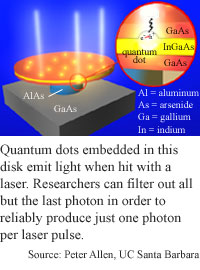
Security comes one photon at a time
By Eric Smalley, Technology Research NewsTwo teams of researchers have created devices for generating the smallest amount of light possible, an advance that brings the age-old dream of foolproof secrecy a big step closer to reality.
Research teams at Stanford University and University of California at Santa Barbara have taken different routes to produce devices that reliably generate one photon at a time.
The devices, coupled with existing quantum cryptography schemes that require single-photon emitters, could make it possible for two people to communicate with the certainty that no one else can intercept their messages.
Today's standard encryption uses large, randomly generated numbers, or keys, to produce unique algorithms that scramble transmissions. An encrypted message can only be opened using the key.
Because it is impossible to observe a particle, such as a photon, in its quantum state without altering that state, anyone who eavesdrops on a message encoded in quantum particles will alter the message and reveal the security breach. If one person sends a key to another using quantum cryptography and they see that no one intercepted it, they can safely use the key to encrypt their communications.
Quantum cryptography requires sending only one photon at a time. "If you had two photons per pulse or more, in principle someone could use a beam splitter and take a couple of those photons and you wouldn't know it," said W. E. Moerner, a chemistry professor at Stanford University.
The Stanford researchers' device consists of individual terrylene molecules embedded in crystals. The UC Santa Barbara device consists of quantum dots embedded in a semiconductor disk about five microns in diameter -- about the size of a red blood cell. Quantum dots are tiny amounts of semiconductor material that confine electrons.
The Stanford device uses a pulse of laser light to add energy to, or pump, one of the molecules. When the pulse stops, the molecule releases the extra energy in the form of a single photon.
Eighty-six percent of the time the device produced one photon and 14 percent of the time it produced no photons, said Moerner. In contrast, devices that simply diminish light in order to avoid multiple photon emissions produce no photons nearly all of the time, he said. The researchers could increase the efficiency to 90 to 95 percent by using a laser 10 times more powerful than the one used in the experiment, he said.
In addition to its relatively high efficiency, the Stanford device operates at room temperature, said Moerner.
The researchers are working on controlling the direction of the photon emission to improve the detection rate, and eliminating photons generated from the background material.
The UC Santa Barbara quantum dots emit a large number of photons when they are pumped with a laser but the system uses filters to isolate the last photon released, said Atac Imamoglu, a professor electrical engineering and physics at UC Santa Barbara.
"We only observe the last photon to be emitted by the quantum dot, which has a different energy than the preceding photons. The last photon is always emitted and emitted at the same energy, irrespective of the total number of photons," he said.
The UC Santa Barbara device operates at very low temperatures. The researchers are working on increasing the temperature to make it more practical. A room temperature version is theoretically possible, according to Imamoglu.
The demonstrations of single-photon emitters are important advances that could lead to experimental demonstrations of quantum cryptography in about three years, said Richard J. Hughes, a physicist at Los Alamos National Laboratory. The emitters are also faster than the current generation of single-photon detectors, which should spur researchers to improve detectors, he said.
"I think in two to three years time we could see our device used in practical quantum cryptography, but... not for everyday applications," said Imamoglu. It will likely take 5 to 10 years before the Stanford device could be implemented in a practical system, Moerner said.
Moerner's research colleague was Brahim Lounis. They published the research in the September 28, 2000 issue of Nature. The research was funded by Stanford University, NATO and the National Science Foundation.
Imamoglu's research colleagues at UC Santa Barbara were Peter Michler, Alper Kiraz, Christoph Becher, Winston V. Schoenfeld, Pierre M. Petroff, Lidong Zhang and Evelyn Hu. They published their work in the December 22, 2000 issue of Science. The research was funded by the David and Lucile Packard Foundation, the Army Research Office, the Max Kade Foundation and the Deutsche Forschungsgemeinschaft.
Timeline: 2 to 3 years, 5 to 10 years
Funding: Private, University, Government
TRN Categories: Semiconductors and Materials; Quantum Computing
Story Type: News
Related Elements: Technical paper, "Single photons on demand from a single molecule at room temperature," Nature, September 28, 2000; Technical paper, "A Quantum Dot Single-Photon Turnstile Device," Science, December 22, 2000
Advertisements:
January 3, 2001
Page One
Gels make micro plumbing
Security comes one photon at a time
Shining a new light on electron spin
Network similarities run deep
Transistor lights up

News:
Research News Roundup
Research Watch blog
Features:
View from the High Ground Q&A
How It Works
RSS Feeds:
News
Ad links:
Buy an ad link
| Advertisements:
|
 |
Ad links: Clear History
Buy an ad link
|
TRN
Newswire and Headline Feeds for Web sites
|
© Copyright Technology Research News, LLC 2000-2006. All rights reserved.